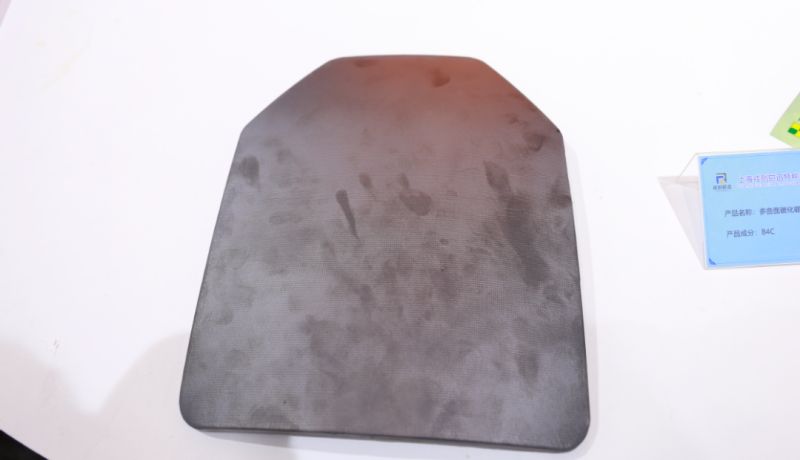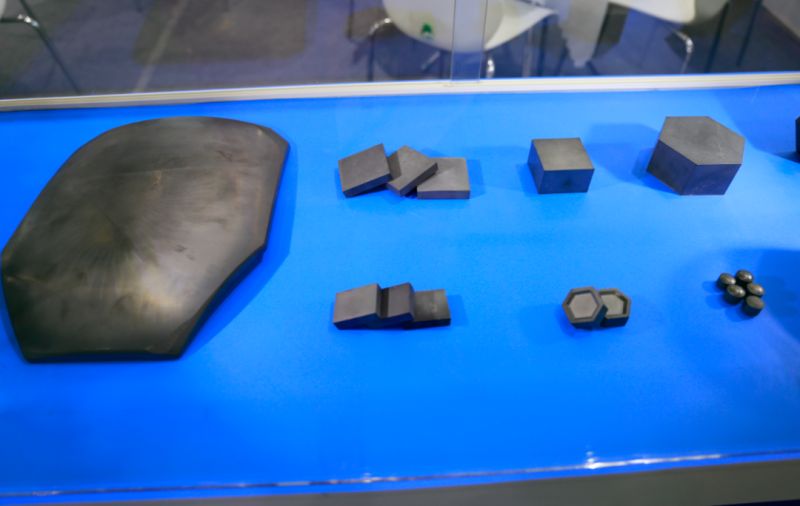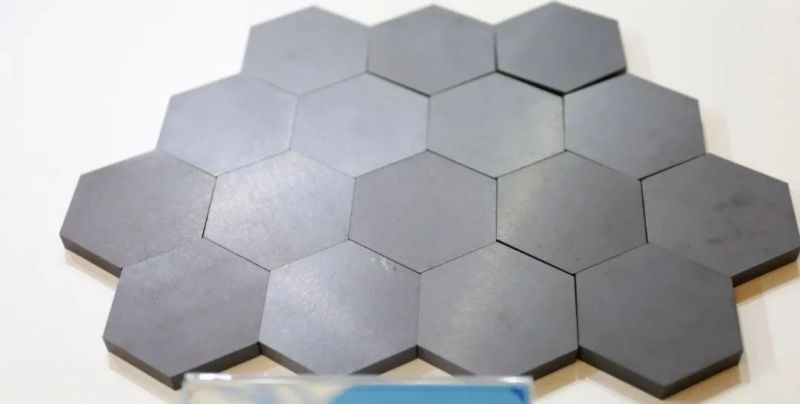③The most commonly used bulletproof ceramic material
Since the 21st century, bulletproof ceramics have developed rapidly, and there are many kinds, including alumina, silicon carbide, boron carbide, silicon nitride, titanium boride, etc., among which alumina ceramics (Al₂O₃), silicon carbide ceramics (SiC), boron carbide ceramics (B4C) are the most widely used.
Alumina ceramics have the highest density, but the hardness is relatively low, the processing threshold is low, the price is low, according to the purity is divided into 85/90/95/99 alumina ceramics, the corresponding hardness and price are also increased in turn.
| Materials | Density /(kg*m²) | Elastic modulus /(GN*m²) | HV | Equivalent to the price of alumina |
| Boron carbide | 2500 | 400 | 30000 | X 10 |
| Aluminium oxide | 3800 | 340 | 15000 | 1 |
| Titanium diboride | 4500 | 570 | 33000 | X10 |
| Silicon carbide | 3200 | 370 | 27000 | X5 |
| Oxidation plating | 2800 | 415 | 12000 | X10 |
| B.C/SiC | 2600 | 340 | 27500 | X7 |
| Glass ceramics | 2500 | 100 | 6000 | 1 |
| Silicon nitride | 3200 | 310 | 17000 | X5 |
Comparison of properties of different bulletproof ceramics
Silicon carbide ceramic density is relatively low, high hardness, is a cost-effective structural ceramics, so it is also the most widely used bulletproof ceramics in China.
Boron carbide ceramics have the lowest density and highest hardness among these ceramics, but at the same time, their requirements for processing technology are also very high, requiring high temperature and high pressure sintering, so the cost is also the highest among these three ceramics.
Compared with these three more common bulletproof ceramic materials, alumina bulletproof ceramics have the lowest cost, but the bulletproof performance is far less than silicon carbide and boron carbide, so the current domestic production units of bulletproof ceramics in silicon carbide and boron carbide bulletproof, while alumina ceramics are rare. However, single crystal alumina can be used to prepare transparent ceramics, which are widely used as transparent materials with light functions, and are applied in military equipment such as individual soldier bulletproof masks, missile detection Windows, vehicle observation Windows, and submarine periscopes.
④Two of the most popular bulletproof ceramic materials
Silicon carbide bulletproof ceramics
The silicon carbide covalent bond is very strong and still has high strength bonding at high temperature. This structural feature gives silicon carbide ceramics excellent strength, high hardness, wear resistance, corrosion resistance, high thermal conductivity, good thermal shock resistance and other properties. At the same time, silicon carbide ceramic price is moderate, cost-effective, is one of the most promising high-performance armor protection materials.
Silicon carbide ceramics have broad development space in the field of armor protection, and their applications in the field of individual equipment and special vehicles tend to be diversified. When used as a protective armor material, considering the cost and special application occasions and other factors, it is usually a small arrangement of ceramic panels and composite backplane bonded into ceramic composite target plate, to overcome the failure of ceramics due to tensile stress, and to ensure that the projectile penetration only shatters a single piece without damaging the entire armor.
Boron carbide bulletproof ceramics
Boron carbide is the hardness of known materials after diamond and cubic boron nitride superhard material, hardness of up to 3000kg/mm²; The density is low, only 2.52g/cm³, which is 1/3 of steel; High elastic modulus, 450GPa; High melting point, about 2447℃; The thermal expansion coefficient is low and the thermal conductivity is high. In addition, boron carbide has good chemical stability, acid and alkali corrosion resistance, at room temperature does not react with acid and base and most inorganic compound liquids, only in hydrofluoric acid-sulfuric acid, hydrofluoric acid-nitric acid mixed liquid has slow corrosion; And most molten metals do not moisten, do not act. Boron carbide also has a good ability to absorb neutrons, which is not available in other ceramic materials. B4C has the lowest density of several commonly used armor ceramics, combined with a high modulus of elasticity, making it a good choice for materials in the military armor and space fields. The main problem of B4C is that it is expensive (about 10 times that of alumina) and brittle, which limits its wide application as single-phase protective armor.
⑤Preparation method of bulletproof ceramics.
| Preparation technology | Process characteristics | |
| Advantage | ||
| Hot press sintering | With low sintering temperature and short sintering time, ceramics with fine grain and high relative density and good mechanical properties can be obtained. | |
| Superhigh pressure sintering | Achieve fast, low temperature sintering, densification rate increased. | |
| Hot isostatic pressing sintering | Ceramics with high performance and complex shape can be prepared by low sintering temperature, short rapping time and uniform shrinkage of bad body. | |
| Microwave sintering | Rapid densification, zero gradient uniform heating, improve material structure, improve material performance, high efficiency and energy saving. | |
| Discharge plasma sintering | The sintering time is short, the sintering temperature is low, the ceramic performance is good, and the density of high energy sintering gradient material is high. | |
| Plasma beam melting method | The powder raw material is fully melted, is not restricted by the particle size of the powder, does not need a low melting point flux, and the product has a dense structure. | |
| Reaction sintering | Near net size manufacturing technology, simple process, low cost, can prepare large size, complex shape parts. | |
| Pressureless sintering | The product has excellent high temperature performance, simple sintering process and low cost. There are many suitable forming methods, which can be used for complex and thick large parts, and also suitable for large-scale industrial production. | |
| Liquid phase sintering | Low sintering temperature, low porosity, fine grain, high density, high strength | |
| Preparation technology | Process characteristics | |
| Disdvantage | ||
| Hot press sintering | The process is more complex, the mold materials and equipment requirements are high, the production efficiency is low, the production cost is high, and the shape can only be prepared with simple products. | |
| Superhigh pressure sintering | Can only prepare products with simple shapes, low production, high equipment investment, high sintering conditions, and high energy consumption. Currently, it is only in the research stage | |
| Hot isostatic pressing sintering | The equipment cost is high, and the size of the workpiece to be processed is limited | |
| Microwave sintering | Theoretical technology needs improvement, equipment is lacking, and has not been widely applied | |
| Discharge plasma sintering | The basic theory needs to be improved, the process is complex, and the cost is high, which has not been industrialized. | |
| Plasma beam melting method | High equipment requirements have not been achieved for widespread application. | |
| Reaction sintering | Residual silicon reduces the high-temperature mechanical properties, corrosion resistance, and oxidation resistance of the material. | |
| Pressureless sintering | The sintering temperature is high, there is a certain porosity, the strength is relatively low, and there is about 15% volume shrinkage. | |
| Liquid phase sintering | It is prone to deformation, large shrinkage and difficult to control dimensional accuracy | |
| Ceramic |
|
AL2O3 . B4 C .SiC |
| AL2O3 |
|
AL2O3 . B4 C .SiC |
| AL2O3 |
|
AL2O3 . B4 C .SiC |
| AL2O3 |
| B4 C .SiC |
|
AL2O3 . B4 C .SiC |
| .SiC |
Bulletproof ceramics upgrade
Although the bulletproof potential of silicon carbide and boron carbide is very large, the problem of fracture toughness and poor brittleness of single-phase ceramics cannot be ignored. The development of modern science and technology has put forward requirements for the functionality and economy of bulletproof ceramics: multi-function, high performance, light weight, low cost and safety. Therefore, in recent years, experts and scholars hope to achieve the strengthening, lightweight and economic of ceramics through micro-adjustment, including multi-component ceramic system composite, functional gradient ceramics, layered structure design, etc., and such armor is light in weight compared with today’s armor, and better improve the mobile performance of combat units.
Functionally graded ceramics show regular changes in material properties through microcosmic design. For example, titanium boride and titanium metal and aluminum oxide, silicon carbide, boron carbide, silicon nitride and metal aluminum and other metal/ceramic composite systems, the performance of the gradient change along the thickness position, that is, the preparation of high hardness transition to high toughness bulletproof ceramics.
Nanometer multiphase ceramics are composed of submicron or nanometer dispersion particles added to the matrix ceramics. Such as SiC-Si3N4-Al2O3, B4C-SiC, etc., the hardness, toughness and strength of ceramics have a certain improvement. It is reported that Western countries are studying the sintering of nano-scale powder to prepare ceramics with a grain size of tens of nanometers to achieve material strength and toughness, and bulletproof ceramics are expected to achieve a big breakthrough in this regard.
Sum up
Whether it is single-phase ceramics or multi-phase ceramics, the best bulletproof ceramic materials or inseparable from silicon carbide, boron carbide these two materials. Especially for boron carbide materials, with the development of sintering technology, the excellent properties of boron carbide ceramics are becoming more and more prominent, and their applications in the field of bulletproof will be further developed.
Post time: Dec-14-2023



